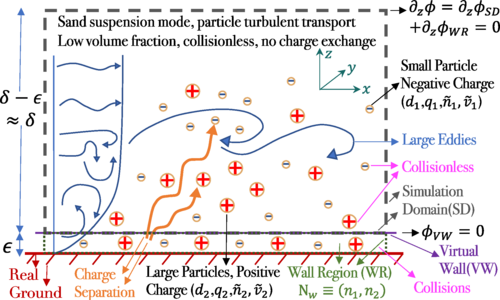Figure 1 The simulation domain (SD). The height of the atmospheric boundary layer δ is modeled as a turbulent half-channel flow with streamwise and spanwise periodic conditions. The lower boundary is modeled as a virtual wall (VW) at ε ( ≪ δ ) height.
A complex weather phenomenon that has puzzled researchers since the nineteenthcentury can now be accurately modeled using a computer simulation framework developed at KAUST.
One lesser-known aspect of sandstorms is that they can generate high-magnitude electrical fields capable of disrupting communication equipment. Recent studies have shown that sand can pick up static electricity through collisions that take place near the ground. Less certain, though, is how the electrified sand behaves once airborne. The observed field strengths require some means of separating oppositely charged particles from each other over large scales.
Ravi Samtaney and his team at KAUST realized that because very few collisions take place between sand particles in the atmosphere, another physical mechanism could be behind electric field formation. They proposed that turbulence—stochastic motion of sand particles embedded in the airflow—might cause sand grains to spontaneously separate. Proving this theory, however, would require some means of simplifying a problem with many dynamic variables.
"Resolving all those sand particles and turbulent motions would require unrealistic computational power," says Samtaney. "So we use what's called a large-eddy simulation, where the tiny fluctuations get smoothed over and only large ones remain. We are situating the model inside the sandstorm, for several minutes or hours, to see what is statistically steady."
As part of his Ph.D. research, Mustafa Rahman joined Samtaney's group to tackle this problem. He helped develop an approach where the turbulent eddies of sandstorms are modeled inside a virtual box that stretches from ground level to kilometer-scale heights in the atmosphere. They controlled the sandstorm's strength with an algorithm that introduces different densities of charged particles into the box, just above the desert floor.
"Near the ground, the turbulent air becomes coupled with the sand transport and they influence each other," says Rahman. "These mechanisms are tricky to model with conventional techniques."
The team spent months of modeling and coding on Shaheen-II, KAUST's massively parallel supercomputer, to resolve the large eddies in sufficient detail. Their computations revealed that smaller-sized grains tended to follow the turbulent flow, but larger grains did not. Because the two size classes of sand grains had opposite charges, this turbulence-based separation created an electric field that sustained itself and reinforced further charge separation, ultimately producing electric fields close to several hundred thousand volts per meter, which accurately match field measurements.
"Reproducing the electric field measurements means our simulation framework may be used as a predictive tool, even for rovers and satellites dealing with dust devils on Mars," says Samtaney.
More information: Mustafa Mutiur Rahman et al. Generation and sustenance of electric fields in sandstorms, Physical Review Research (2021). DOI: 10.1103/PhysRevResearch.3.L012008























